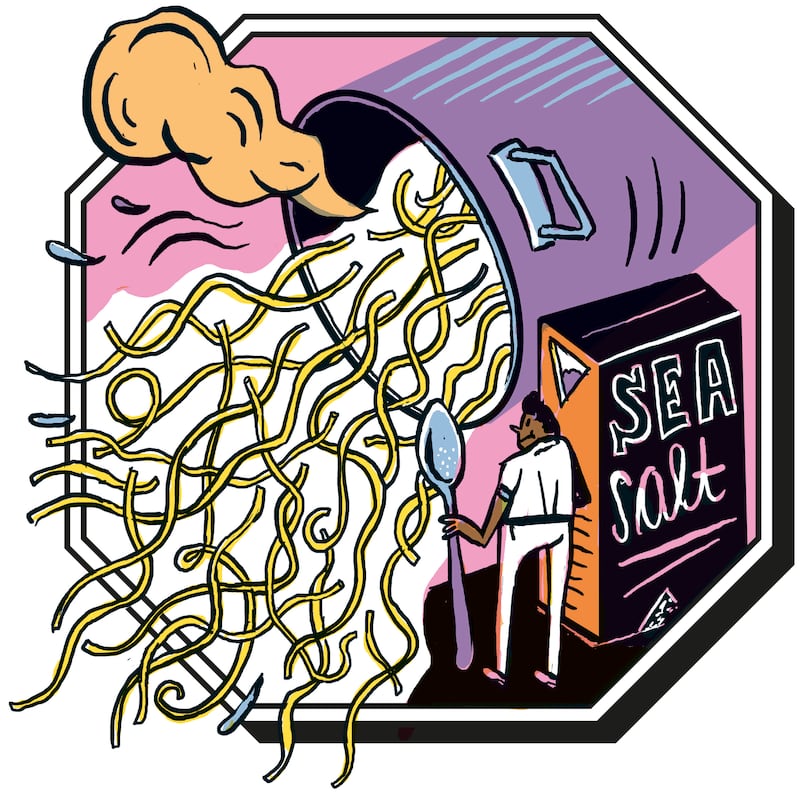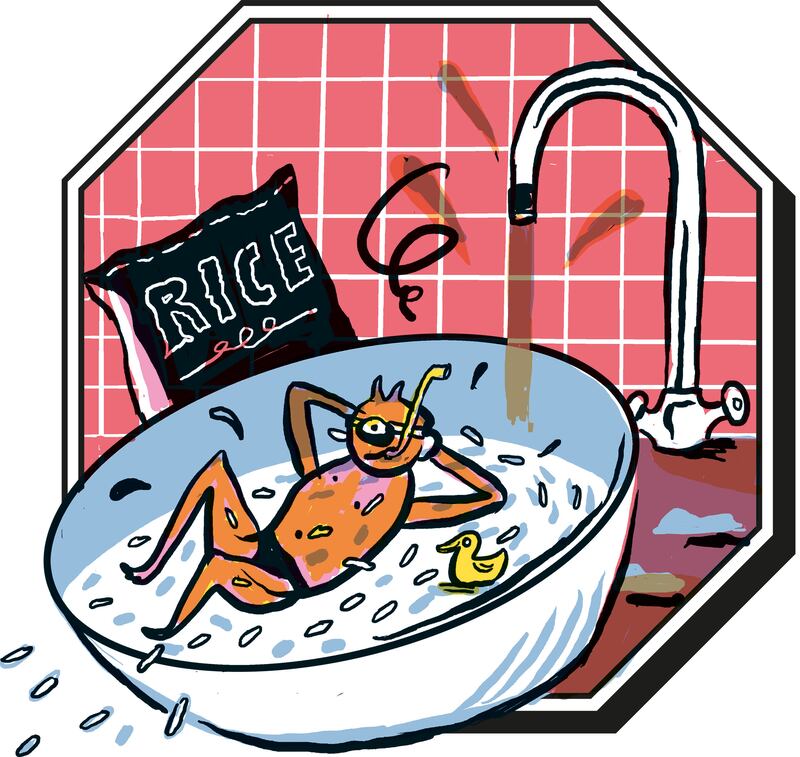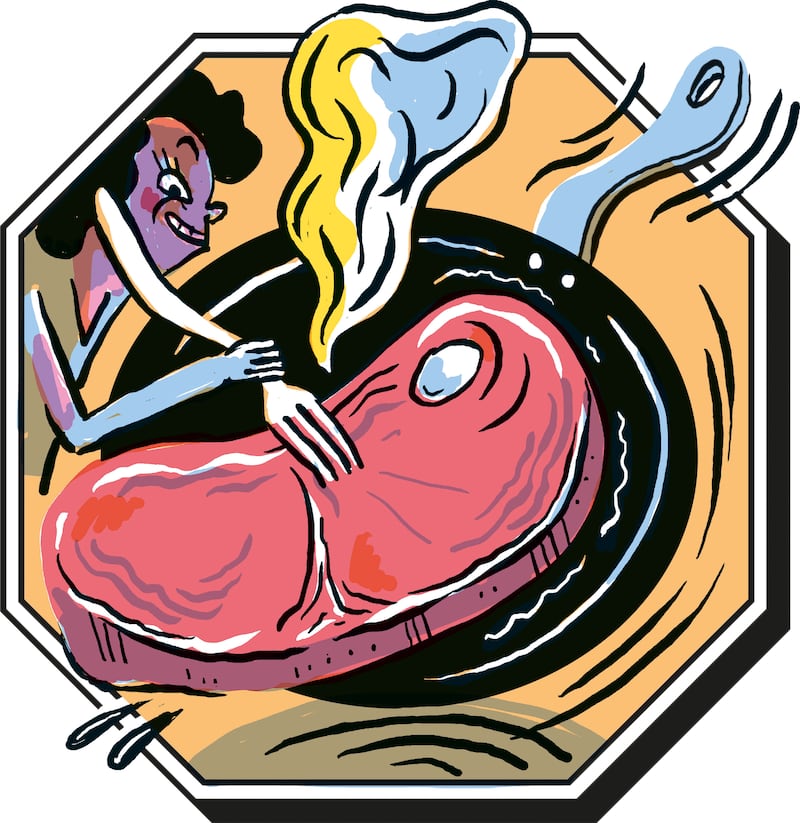Food myths come from many sources, and cooks (including me) have swallowed lots of them. Some of them used to be truths, like the notion that you should eat oysters only in “R” months (before refrigeration, shellfish were safer to eat in the winter). Some come from restaurant kitchens, such as the rule against washing mushrooms. (When you’re ready to use them, it’s perfectly fine to rinse off the dirt. Just don’t store them after washing; they will spoil once wet.) And some just derive from superstition, like the idea that brown eggs are healthier than white ones. (They are identical inside the shell; the colour is determined by the hen’s feathers.)
The five notions below are the ones I’ve believed in the longest – and been most mystified by. I consulted the latest studies, called up experts, bought two extra rice cookers and tracked down farmers to find out once and for all: truth or myth?

TRUTH OR MYTH: Never use soap to wash a cast-iron pan
Apart from the best way to cook rice, nothing gets cooking-science types more riled up than cast-iron pans. If you haven’t cooked in one, you might wonder what all the fuss is about, on the cooking and the cleaning front.
For cooking, cast iron has a great weight and a porous surface – slightly rough, compared with smooth stainless steel or a non-stick coating – that makes it ideal for searing. The surface absorbs oil, which hardens over heat and over time into a shiny, nearly non-stick patina. This process is called seasoning, not in the sense of adding salt to taste but in the sense of developing a well-used, trusted tool.
I have been told that a truly well-seasoned cast-iron pan can cook an omelette without sticking, but I am too scaredto try. I have also been told that the best way to clean my pan is to boil it, to bury it in the sand, and to never wash it at all. None of these seem like practical options.
The prohibition against soap comes from a time when all soap was made with lye, which could eat through a patina in minutes. And it’s true that most of the time, soap is unnecessary. Most of your cleaning power should come from hot water and gentle scrubbing or brushing, the way cast-iron cooking pots such as Chinese woks and Indian kadai are traditionally cleaned.
But sometimes a batch of bacon or a crusty steak leaves more residue in the pan than hot water can handle. A few drops of dishwashing liquid and a plastic scrubber will remove any cooked-on bits and degrease your pan just enough to move on to the final cleaning step. You want the pan to still have a sheen when you place it over low heat to dry out and to bond the latest layer of oil to the surface.
And if you use too much soap or scrub a little too hard (or if you inadvertently put it in the dishwasher), it may remove a little of the patina. But just as a patina can be built, it can be rebuilt: This is when soap comes in handy. With a metal pad, you can scour any rust down to the cast-iron surface, then start the seasoning process over again.
VERDICT: False. As long as you’re not using scouring powder or drain cleaner, a little bit of soap won’t harm your cast-iron pan.

TRUTH OR MYTH: Pasta cooking water should taste as salty as the ocean
Where did this myth come from? Probably not from Italy, where “salted water” is understood to mean a palmful of salt in a standard five-litre pasta pot. (The myth Italian cooks argue about is when, not whether, to add the salt.)
And more important, what does the ocean taste like, anyway? According to Nasa, the average salinity of the Earth’s oceans is 3.5 per cent by weight. That works out to 35g of salt per litre of water.
To test the myth, I cooked eight batches of spaghetti at salt levels ranging from none to Pacific Ocean (3 per cent) to Mediterranean Sea (4 per cent). I can confirm that seawater is too salty. As I worked my way up from a teaspoon to a tablespoon of salt per about 3.7 litres of water , the pasta was noticeably undersalted, and its flavour got lost in the finished dish. I most liked water that tasted as salty as a light chicken stock, or two tablespoons per 3.7 litres of water.
Of course, the salted water rule doesn’t apply to all kinds of noodles. Italian pasta doesn’t contain salt because it interferes with gluten development, which makes it possible to roll pasta into sheets (as for fresh pasta) or extrude it through machines (for dried). Salt is added to the cooking water for flavour, and to make the noodles less sticky.
Asian wheat noodles such as udon and lo mein have alkaline salts added to the dough, and they are traditionally cooked in unsalted water. Rice noodles are unsalted; like rice, they are supposed to taste neutral and fresh, so they are also typically cooked in unsalted water.
VERDICT: False. Salt to taste.

TRUTH OR MYTH: Always wash rice until the water runs clear before cooking.
For centuries, the process of milling rice – white or brown, sticky or sweet – produced bran, chaff and dust, and storing it brought vermin, fungi and spoilage. So for reasons of hygiene, safety and general anti-ick, rice absolutely did have to be washed. This is done in multiple changes of water, until the water, cloudy at the outset, runs clear.
Today, milled rice is sealed in oxygen-free tanks and lasts for decades, and, according to the most recent research, washing doesn’t affect the way the rice cooks. Modern growers say washing is unnecessary. So is there any need to? And if so, is a quick rinse enough or are we talking about multiple changes of water?
The answer depends on what kind of rice you’re cooking.
Instead of measuring short, medium and long grains, it makes more sense to think of the world’s two main varieties of rice: indica and japonica. Most rice is indica; it can be long or medium-grain and includes Indian basmati, Thai jasmine, Carolina among others., Japonica rice includes Spanish bomba, Italian Arborio and Japanese rice such as Koshihikari and Nishiki; most, but not all of it is short-grain.
All of it now arrives in domestic kitchens milled, cleaned and lightly dusted in its own starch. But at the molecular level, the way the starches behave is slightly different. As the microscopic granules swell with hot water and burst while cooking, japonica releases more sticky starch. That’s (part of) why indica cooks up lighter and drier and japonica is denser, with a pearly sheen. Both types can be sticky enough to cling together when cooked, but you shouldn’t feel starch on your teeth.
Having always wondered if I could tell the difference between washed and unwashed rice, I bought an extra rice cooker and cooked three kinds of washed and unwashed rice side by side: Koshihikari, jasmine and basmati.
For the indica rices (jasmine and basmati), the difference between unwashed and rinsed rice was imperceptible. For the japonica, to my taste the washed rice had just a microdose less starch, taking it from already excellent to perfect.
VERDICT: False. Short-grain and medium-grain (japonica) rice can be washed to reduce stickiness, but it’s not required; long-grain rice (indica) just needs a rinse.

TRUTH OR MYTH: Have all of your ingredients prepared and your cooking oil heated before starting to cook
So many dishes around the world begin by cooking some combination of aromatics (garlic, ginger, chilis, lemon grass) and vegetables (onions, celery, carrots) in hot fat, whether as a sofrito, a mirepoix, a recaito or a ginisa. And most published recipes – including many available in The Irish Times recipes section – instruct you to prepare all of the ingredients separately, heat the oil (or butter or lard) until “shimmering” (or the like) and then begin to cook.
But years ago, I started to rush the process by adding ingredients directly from the cutting board to the pan with the oil. Now I set the pan over low heat and warm the ingredients as I work, stirring in each new ingredient as it’s ready. The heat goes up only once everything is minced, chopped, diced and coated evenly with oil.
This may not be exactly a eureka moment for most cooks, but it goes against the instructions in nearly every published recipe. The myth that all of the ingredients need to be prepared before any cooking starts comes to us from restaurant kitchens, where the concept of “mise en place”, French for put in place, is fundamental.
From outdoor stalls to high-end kitchens, professional cooks start with prepped ingredients and cook them to order, with attention focused on that one pot (or pan, or wok or tadka) at a time. For stir-frying, where the cook is constantly moving the food around in the pan, this works great. And when deep-frying or pan-frying, starting with an empty pan and super-hot oil is integral to the cooking process.
But for slower food, such as soups and stews, it’s perfectly fine to start the pan over low heat, and turn the heat to high only once everything is in. Diced vegetables such as onions and celery take longer to cook than minced aromatics (think ginger and garlic) so put the vegetables in first. They will soften, and then turn golden, and then – quite a lot later – caramelise. (Speaking of: Another persistent myth in cooking is that it takes eight to 10 minutes to caramelise onions, which is pretty much impossible unless you are a restaurant chef and stirring onions over high heat is your only job.)
VERDICT: False. When cooking something in a flash, preheated oil and prepped ingredients are necessities. But for other recipes, low and slow is a great start.

TRUTH OR MYTH: Always brown meat at the beginning of the cooking process, to ‘seal in’ the juices
Historians like to argue about when humans discovered cooking (anywhere from two million to 70,000 years ago), but they do agree on this: Roasting meat (or poultry, fish, reptiles or amphibians) over an open flame was our first step toward home cooking.
But it wasn’t until a century ago that French scientist Louis-Camille Maillard identified the source of the delicious aromas and flavours produced by cooking proteins and sugars over high, dry heat. Maillard reactions are what make dry-roasted things such as bread crusts, coffee beans and chicken skin taste and smell so good.
A lot of cooking is about generating those reactions, from tossing beef in a wok over high heat to coaxing a Christmas turkey to achieve crisp skin. But that browned surface doesn’t actually keep the juices – a combination of blood, fats and collagen – in the meat.
If you’ve ever spent an hour patiently browning chicken thighs in batches, only to move to the next step and find you’re about to submerge them in liquid that will reduce the skin to flab, you may have wondered what all that work was for. Many traditional stews are built without it: a Central American jocón, a West African mafe and a Provençal daube all skip browning and rely on other ingredients to deepen their flavours.
Many stew recipes from European traditions call for a first step of browning the meat – sometimes “all over” – a process that creates extra mess and tedium. It isn’t about keeping the meat juicy or tender; it’s about building those delicious cooked bits at the bottom of the pan, the fond, to flavour the cooking liquid.
There are many other ways to make meat succulent – poaching it as in Hainanese chicken or braising it as in Indian curries – but browning isn’t one of them. Skip it if you wish, and try letting your stews rest overnight instead to deepen the flavours.
VERDICT: False. Browning is great for dry-heat dishes such as steaks and roasts, but unnecessary for stews and braises. – This article originally appeared in The New York Times.











